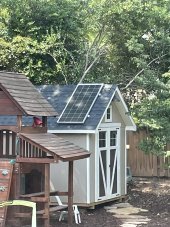I have a new shed solar system I set up in the last 90 days. I have a Grape Solar 200-Watt solar panel, a 40 AMP Grape Solar charge controller, a 3000 W Renogy inverter (upgraded from my original 1000 W) and a Renogy battery monitor. The battery is a 12V Renogy 100AH gel battery. I have a new LED motion sensor light on the interior that only comes on when I go inside and an LED lamp on the exterior which goes on at dark and off at dawn. I also have a power strip plugged in inside the shed with a router plugged in. I don't think i am using my power at all. The system worked great for 60+ days. A week or so ago i went into the shed and the battery monitor was showing no charge left. Previously this thing would always show 99-100% charge any time i would go in there. It would then drop only if i was in the shed for an extended period of time and the light was on - but it would barely drop. Any idea as to why the battery would suddenly dissipate all of the sudden? The cables all seem tight and the controller shows it's getting power from the panel. All parts were new upon install including the battery.
I am racking my brain to figure it out. It's frustrating when it works for a period and suddenly is acting weird after a short period. Here are a few things which may or may not have impacted the situation:
1) I replaced the inverter from a 1K W to 3K - same brand of Renogy but basically a swap out. Prior to to swapping i tried plugging in a saw that clearly needed more power than my 1K inverter could supply - hence the swap out. That was the only time I tried running that saw and then i swapped out the inverters. I guess this could've caused some issue but i swapped the inverters and everything seemed fine. That was maybe 3-4 weeks ago and about 2-3 weeks after that is when i started having battery issues.
2) I read that the Renogy Battery i have has a max charge current of 30A. The charge controller is a 40A charge controller. I am not sure if that impacts anything over time? The charge controller correctly detected the battery type as gel. I don't think i needed to change any other settings as i believed they were all accurate.
3) It is going into summer time and the shed is heating up during the day. I read that heat can impact batteries but frankly it hasn't been that hot and the battery went from being fine to not fine in a week or so which leads me to believe it's something other than the temp affecting the battery.
I have provided a few pics of my setup below. Any help or ideas would be greatly appreciated. Thank you!
I am racking my brain to figure it out. It's frustrating when it works for a period and suddenly is acting weird after a short period. Here are a few things which may or may not have impacted the situation:
1) I replaced the inverter from a 1K W to 3K - same brand of Renogy but basically a swap out. Prior to to swapping i tried plugging in a saw that clearly needed more power than my 1K inverter could supply - hence the swap out. That was the only time I tried running that saw and then i swapped out the inverters. I guess this could've caused some issue but i swapped the inverters and everything seemed fine. That was maybe 3-4 weeks ago and about 2-3 weeks after that is when i started having battery issues.
2) I read that the Renogy Battery i have has a max charge current of 30A. The charge controller is a 40A charge controller. I am not sure if that impacts anything over time? The charge controller correctly detected the battery type as gel. I don't think i needed to change any other settings as i believed they were all accurate.
3) It is going into summer time and the shed is heating up during the day. I read that heat can impact batteries but frankly it hasn't been that hot and the battery went from being fine to not fine in a week or so which leads me to believe it's something other than the temp affecting the battery.
I have provided a few pics of my setup below. Any help or ideas would be greatly appreciated. Thank you!
Attachments
Last edited:






